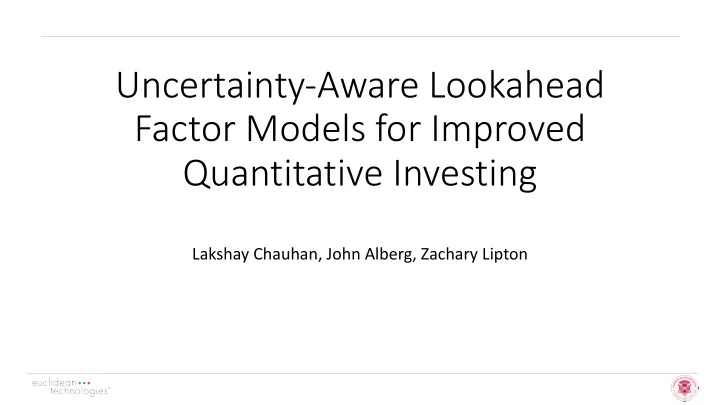

Uncertainty-Aware Lookahead Factor Models for Improved Quantitative Investing Lakshay Chauhan, John Alberg, Zachary Lipton
Overview Improve quantitative investing by forecasting fundamentals and measuring uncertainty Quantitative Investing • Portfolios are constructed by ranking stocks using a factor • factors based on fundamentals such as Revenue, Income, Debt • Standard quantitative investing uses current fundamentals • Investment success what a company does in the future Can we use forecast future fundamentals then?
Overview Improve quantitative investing by forecasting fundamentals and measuring uncertainty Our Contribution • Show value of forecasting fundamentals • Forecast future fundamentals using neural networks and measure uncertainty • Use uncertainty estimate to reduce risk as measured by Sharpe Ratio • Portfolio return and risk are significantly improved
Motivation Quantitative Investing Value Factors Ranking Factor - Dividend Yield Factors Southern Dividend Yield 𝐺𝑣𝑜𝑒𝑏𝑛𝑓𝑜𝑢𝑏𝑚 𝐽𝑢𝑓𝑛 (𝑜𝑓𝑢 𝑗𝑜𝑑𝑝𝑛𝑓, 𝐹𝐶𝐽𝑈) Hewlett Packard Earnings Yield 𝑇𝑢𝑝𝑑𝑙 𝑄𝑠𝑗𝑑𝑓 Portfolio Pfizer Book-to-Market Pick top N ranked Verizon Value factors outperform market averages (SP500) by a factor Momentum US Bancorp Duke Energy Leggett & Platt Omnicom Group Limitation Factor models rely on current period fundamentals, but returns are driven by future fundamentals Solution Build factor models using forecast future fundamentals
Motivation Clairvoyant Factor Model • Imagine we had access to future fundamentals • Simulate performance with future fundamentals (2000-2019) • Clairvoyant fundamentals offer substantial advantage • This motivates us to forecast future fundamentals Problem Set up • Use EBIT as the fundamental to create value-factor • Forecast EBIT 12 months into the future
Data Background • US stocks from 1970-2019 traded on NYSE, NASDAQ and AMEX (~12,000), Market Cap > $100M • Time series of 5 years with step size of 12 months Target Input Series IBM Jan, 2000 Jan, 2001 Jan, 2002 Jan, 2003 Jan, 2004 Jan, 2005 IBM Feb, 2000 Feb, 2001 Feb, 2002 Feb, 2003 Feb, 2004 Feb, 2005 IBM Mar, 2000 Mar, 2001 Mar, 2002 Mar, 2003 Mar, 2004 Mar, 2005 Feature Examples • Fundamental Momentum Auxiliary Revenue 1-month relative momentum Short Interest Cost of Goods Sold 3-month relative momentum Industry Group Earnings Before Interest and Taxes (EBIT) 6-month relative momentum Company size category Current Debt 9-month relative momentum Long Term Debt
Forecasting Model 1970 2000 2019 Random 70-30 train-validation split Out of Sample Test Set Training Set • In-sample validation set is used for genetic algorithm based hyper-parameter tuning • Multi-task learning to predict all fundamental features instead of just EBIT • Increases training signal Multi-task Learning • Improves generalization Predict all fundamentals • Use Max Norm and Dropout for regularization Input Layer � � ¹ � Hidden Layer � � ¹² Hidden Layer � � ¹ � Output Layer � ��
Uncertainty Quantification • Financial data is heteroskedastic i.e. noise is data dependent • Some companies will have more uncertainty in their earnings than others due to size, industry, etc. Mean • Jointly model mean and variance by splitting final layer • First half predicts means of targets Variance Second half predicts variance of the output values or aleatoric uncertainty • prediction accuracy Input Layer � � ¹ � Hidden Layer � � ¹² Hidden Layer � � ¹ � Output Layer � � ¹ � penalize over-confident minimize uncertainty model (narrow bounds) Epistemic Uncertainty = Variance in outputs across Monte Carlo draws of dropout mask Total Uncertainty = Aleatoric Uncertainty + Epistemic Uncertainty
Constructing Factor Models Definitions Factor Models EV - Enterprise Value QFM LFM Auto Reg QFM - Quantitative Factor Model LFM Linear LFM MLP LFM - Lookahead Factor Model LFM LSTM LFM UQ-MLP LFM UQ – Uncertainty Quantified Model LFM UQ-LSTM Companies with higher variance are riskier Higher variance = less certain about forecasts • Therefore, scale factor in inverse proportion to • variance
Portfolio Simulation • Industry grade, high fidelity investment portfolio simulator • Portfolios formed of top 50 stocks ranked by factor • Rebalance portfolio monthly • Simulate 50 years of performance, many economic cycles • Point-in-time data, no survivorship or look-ahead bias • Include transactions cost, price slippage to reflect realistic trading • Measure performance by Compound Annualized Return (CAR) and Sharpe Ratio Simulated returns of a quantitative strategy vs. the real returns generated from live trading of the same strategy
Results Out-of-Sample Performance 2000-2019 Pairwise t-statistic for Sharpe ratio with ⍺ =0.05 significance level of 0.05. Strategy MSE CAR Sharpe Ratio Auto-Reg Linear MLP LSTM UQ-LSTM UQ-MLP 6 . 05% 0 . 32 n/a S&P 500 QFM 0 . 76 2 . 52 2 . 93 2 . 96 5 . 57 6 . 01 0 . 65 14 . 0% 0 . 52 QFM Auto Reg 1 . 89 2 . 31 2 . 36 5 . 10 5 . 57 0 . 58 14 . 2% 0 . 56 LFM Auto Reg Linear 0 . 36 0 . 46 3 . 12 3 . 66 0 . 52 15 . 5% 0 . 64 LFM Linear MLP 0 . 10 2 . 82 3 . 39 0 . 48 16 . 1% 0 . 68 LFM MLP LSTM 2 . 66 3 . 22 0 . 48 16 . 2% 0 . 68 LFM LSTM 0 . 48 17 . 7 % 0 . 84 LFM UQ-LSTM 0 . 47 17 . 3 % 0 . 83 LFM UQ-MLP
Results Cumulative return of different strategies from 2000 to 2019
Conclusion • Forecasting fundamentals is valuable in quantitative investing • Use DNN to forecast future fundamentals and estimate uncertainty • Improve return and Sharpe ratio
Thank You lakshay.chauhan@euclidean.com john.alberg@euclidean.com zlipton@cmu.edu
Recommend
More recommend